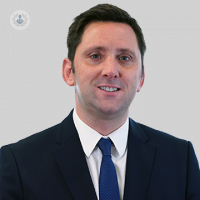Facelift and rhinoplasty surgery: what you need to know
Written by:Cosmetic surgery can mean many things, with various procedures that could be done for a number of reasons. Facelift and rhinoplasty are both popular examples that can have an anti-ageing effect. What do they involve? Experienced plastic surgeon Mr Paul Tulley is here to explain and offer expert advice.

What does a facelift involve?
A facelift is a highly effective method to rejuvenate the face. It involves assessment in clinic, usually over two to three appointments, where we'll establish the aims of the patient and examine them in detail. From there, we'll select procedures from a range of options, for example a mini-facelift vs. full face-and-neck lift, together with any procedures like:
- eyelid surgery,
- brow lift , or;
- fat grafting to the face.
Younger patients with better necks may often be suitable for a mini-facelift alone. Older patients, particularly where their neck slacks, are probably best suited to a full face-and-neck lift and we'll also discuss with the patient any additional procedures that may be of benefit to them.
Incisions are made on the front of the ear alone if it's a mini-facelift; if it's a full face-and-neck lift, the incision will extend around the back of the ear and into the adjacent hairline. The skin envelope is then raised and the deeper tissues which are called the SMAS tissues in the face are re-suspended and re-contoured to produce the new rejuvenated shape. This usually results in:
- a fuller cheek;
- slimmer lower face;
- sharper neckline, and;
- a sharper jawline.
Facelift surgery takes place over a number of hours and normally requires a night in hospital. Drains are placed together with head bandage, which we remove the following day before the patient goes home and then return for stitches at about a week post-op. They'll normally need about 2 to 3 weeks’ downtime to recover from the facelift procedure.
What is a rhinoplasty?
Rhinoplasty is a procedure to produce a more idealised version of a patient's nose that will fit optimally with the rest of their face. Usually, we'll see the patient for assessments at least a couple of times in clinic to establish their aims and to take a number of detailed measurements. From there, we'll recommend a treatment plan for the patient.
Rhinoplasty surgery could be either an open or a closed rhinoplasty. Closed rhinoplasty involves incisions just on the inside of the nostrils. An open rhinoplasty involves a small incision between the nostrils also. From there, we will normally elevate the skin envelope or find the tip and then address the bridge. This may involve removing a hump or straightening the dorsal profile. We also often narrow the bridge and commonly reduce the whole size of the nose, perhaps shortening it. This may also involve adding some cartilage grafts to produce support or adjust the shape in certain areas.
For patients with a deviated nose, we may need to straighten the nose; if they have an ethnic nose, we may need to augment the dorsum to increase the profile.
After surgery, the patient normally has a pack overnight and a plaster on for about ten days. They'll come back to clinic for removal of the plaster and then we'll tape the nose usually for another three to four days afterwards. The patient now needs about two weeks downtime from their work and social activities and normally has a pretty good view of the new shape of the nose by two to four weeks, but the final results can take longer – up to about nine months to see the final shape, particularly around the tip, as the swelling settles.
Which should I have first? A facelift or a rhinoplasty?
Regarding facelifts and rhinoplasty surgery, there's not necessarily a strict order as to which should be done first. It really depends on the patient's priorities. If a patient's got a very strong nose that's causing them a lot of distress, as opposed to facial laxity, they'll tend to prioritise the nose first. If ageing is a much more significant problem rather than nose shape, then they'll usually look to address that sooner. There may be some discussion among surgeons to whether the order affects the reshaping of the skin around the face and nose, but I don't feel this is a significant issue.
Can you have a facelift and a rhinoplasty together?
It's possible to have a facelift and a rhinoplasty together, but it depends on the length and complexity of each procedure. For example, in a relatively younger patient with a more straightforward rhinoplasty, who is perhaps having a mini-facelift, it may well be possible to combine the procedures, which are not likely to be too long. However, in an older patient who may be getting a more extensive facelift surgery such as a full face-and-neck lift, perhaps together with further neck surgery, brow lifting, eyelid surgery or fat grafting, this procedure can be quite a lot longer. Combining it with a rhinoplasty in addition, it is likely to lead to long times under anaesthesia. For the older patient, it's probably better to separate the procedures.
What is your advice for patients requesting aesthetic surgery?
Patients looking to undergo cosmetic surgery should have a clear view of the aims and results they'd like to achieve from the treatments. They perhaps have researched it online or from other sources, but optimally they would take an opinion from more than one surgeon to get a range of views. It is best to see a surgeon who's specialised in cosmetic surgery and is on the GMC specialist register for plastic surgery. It's also worth checking if they're a member of a professional cosmetic surgery body such as BAAPS or BAPRAS.
When they go to their consultation, they should make sure they're seeing the surgeon who's actually going to do the procedure rather than a salesperson, nurse or another person. They should allow plenty of time to discuss the facelift or rhinoplasty procedure with the patient and to examine them in detail. Patients should also look to see photos of their work and perhaps speak to one of their previous patients.
If you're interested in a facelift or rhinoplasty, visit Mr Tulley’s Top Doctors profile to book an appointment.


